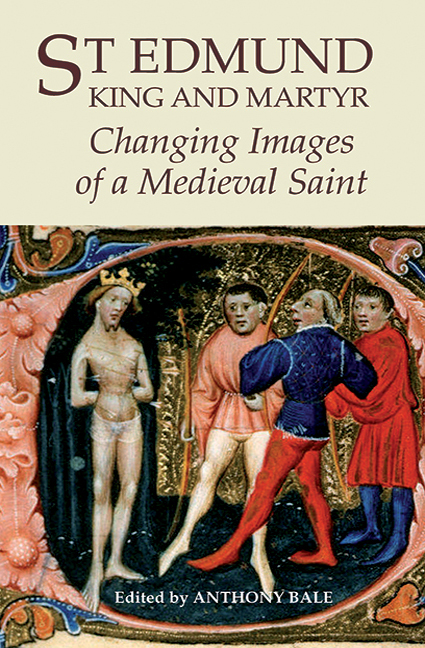Book contents
- Frontmatter
- Contents
- Preface
- List of Contributors
- List of Abbreviations
- Introduction: St Edmund's Medieval Lives
- 1 King, Martyr and Virgin: Imitatio Christi in Ælfric's Life of St Edmund
- 2 Chronology, Genealogy and Conversion: The Afterlife of St Edmund in the North
- 3 Geoffrey of Wells’ Liber de infantia sancti Edmundi and the ‘Anarchy’ of King Stephen's Reign
- 4 Music and Identity in Medieval Bury St Edmunds
- 5 Medieval images of St Edmund in Norfolk Churches
- 6 John Lydgate's Lives of Ss Edmund and Fremund: Politics, Hagiography and Literature
- 7 St Edmund in Fifteenth-Century London: The Lydgatian Miracles of St Edmund
- 8 The Later Lives of St Edmund: John Lydgate to John Stow
- Select Bibliography
- Index
- Miscellaneous Endmatter
4 - Music and Identity in Medieval Bury St Edmunds
Published online by Cambridge University Press: 11 May 2017
- Frontmatter
- Contents
- Preface
- List of Contributors
- List of Abbreviations
- Introduction: St Edmund's Medieval Lives
- 1 King, Martyr and Virgin: Imitatio Christi in Ælfric's Life of St Edmund
- 2 Chronology, Genealogy and Conversion: The Afterlife of St Edmund in the North
- 3 Geoffrey of Wells’ Liber de infantia sancti Edmundi and the ‘Anarchy’ of King Stephen's Reign
- 4 Music and Identity in Medieval Bury St Edmunds
- 5 Medieval images of St Edmund in Norfolk Churches
- 6 John Lydgate's Lives of Ss Edmund and Fremund: Politics, Hagiography and Literature
- 7 St Edmund in Fifteenth-Century London: The Lydgatian Miracles of St Edmund
- 8 The Later Lives of St Edmund: John Lydgate to John Stow
- Select Bibliography
- Index
- Miscellaneous Endmatter
Summary
Evidence of the musical practices, ideas and works of medieval England has largely disappeared, and it is necessary to approach what remains with caution. Nevertheless, even the smallest fragments of plainchant and polyphony offer an irresistible challenge to scholars trying to piece together the soundscape of this period, one that is all too easily forgotten by historians whose primary interest is not music. The abbey at Bury St Edmunds once owned a significant quantity of music, including items in honour of its patron, St Edmund. The repertoire that survives from the late Middle Ages, including liturgical chant and polyphony, suggests that the monastic community used lyrics as a means of forging and expressing Bury's identity, as a place of pilgrimage and as a Benedictine monastery frequently under attack from outsiders, both real and imagined. The present study focuses on aspects of local identity and the ‘Other’ in the music from Bury St Edmunds, and includes transcriptions of previously unpublished plainchant for the Office of St Edmund.
The main kind of music performed in religious services was plainchant, liturgical text sung as a single melodic line. This would have been performed by the abbey's monks and by priests working elsewhere in Bury's various religious institutions, some sections by solo voices and others by the full community or choir. Though liturgical chant was written into Bury's service books with pitch-specific music notation from at least the post-Conquest period, it was learned by rote and performed largely from memory. The service books that belonged to the abbey at Bury St Edmunds can be traced via the various catalogues that were copied during the Middle Ages and in later centuries, as well as through the examination of extant sources. There are a number of surviving plainchant sources from Bury, including four complete books and six fragments. In addition to these, special occasions, perhaps including recreational activity, inspired the copying or composition of polyphonic music (music in two or more parts). Polyphonic music was performed by a small group of soloists, and was disseminated in written form because it required strict uniformity in the interpretation of melody, rhythm and harmony in order to function effectively. This essay discusses both monophonic and polyphonic music from Bury, and highlights the aspects of local tradition and identity that were part of its liturgical customs.
- Type
- Chapter
- Information
- St Edmund, King and MartyrChanging Images of a Medieval Saint, pp. 87 - 110Publisher: Boydell & BrewerPrint publication year: 2009



